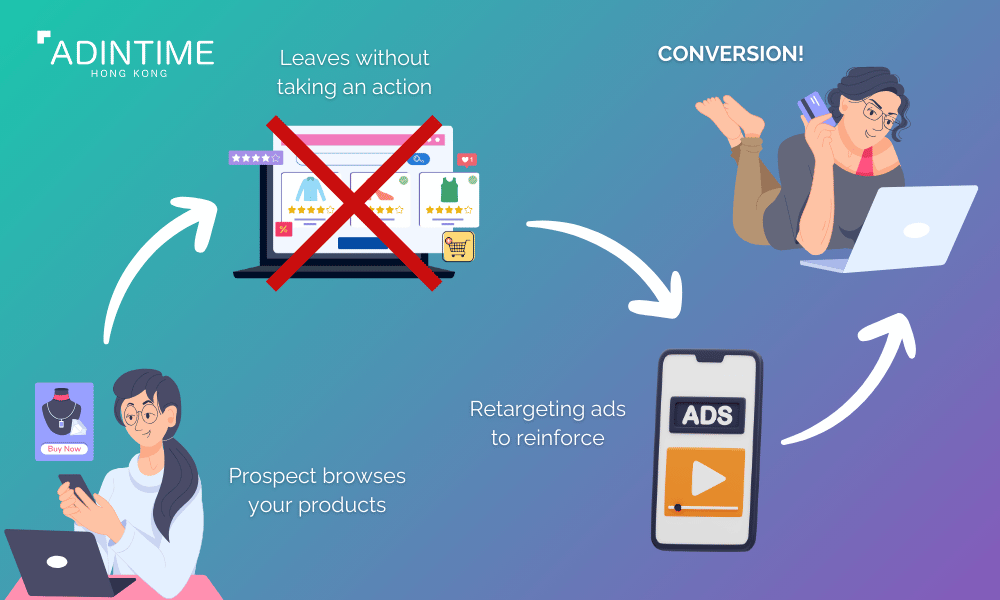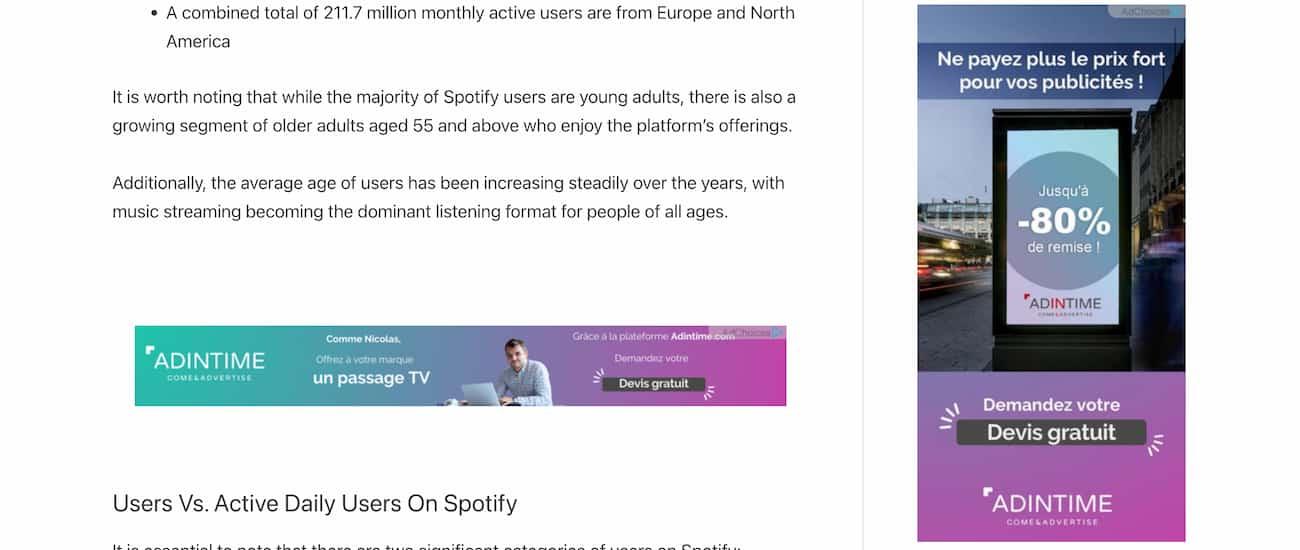Retargeting Ads Definition & How to Set Up Retargeting Campaigns
Want to save time?
Summarize this article in seconds with AI
Imagine a potential customer visits your website, browses your products, maybe even adds something to their cart, and then—just leaves. Frustrating, right? It happens more than you'd think—97% of visitors leave without taking any action.
But instead of waving goodbye, what if you could remind them of what they almost bought, enticing them to return and complete the purchase?
That’s where retargeting ads come in, offering a second chance to convert those missed opportunities into loyal customers. Let's explore how retargeting can drive better results for your business and elevate your marketing game.
Jump to...
- Retargeting Ads Definition
- Benefits of Retargeting
- Different Types of Retargeting Ads
- How to Set Up Retargeting Campaigns
- How to Use Retargeting Ads to Maximize ROI
- Conclusion
- Did you know...(O2O tool)
Retargeting Ads Definition

At its core, retargeting ads are a form of online advertising that targets people who have previously interacted with your brand. Whether they visited your website, added an item to their shopping cart, or opened one of your emails but didn’t take any action, these ads aim to keep your business at the forefront of their minds and encourage them to return and complete their action.
How retargeting ads work is fairly straightforward. Through the use of cookies or pixels, when someone visits your site, a small piece of code is placed in their browser, allowing you to show them ads on other platforms, such as Google, Facebook, or display ad networks. This is called display retargeting, and it’s one of the most effective ways to reconnect with potential customers.
Benefits of Retargeting
Is retargeting effective? Yes, absolutely. And its benefits can be summarized into three key advantages:
- Increased Conversions: By reminding visitors about your brand, retargeting ads can significantly improve your chances of converting them into paying customers.
- Cost-Effective: Retargeting focuses on an audience that has already expressed interest in your business, which can lead to higher ROI compared to cold outreach.
- Improved Brand Recall: With so much competition, staying top-of-mind is critical. Retargeting helps you consistently re-engage with your audience.
Different Types of Retargeting Ads
There are several ways to implement a retargeting campaign, each with its own strategy:
Display Retargeting: This method shows banner ads to people who have visited your website as they browse other sites across the web. It’s great for increasing awareness and encouraging return visits.
Here's an in-house example from Adintime France:
Email: In email marketing-retargeting, you can target users based on their interactions with your email campaigns. For instance, if a recipient clicks on a product link but doesn’t make a purchase, they can be retargeted with display ads that feature the same product. Email retargeting platforms like Brevo and AdRoll help automate these campaigns, driving users back to your website. Just like this one:

Social Media Retargeting: Platforms like Meta allow for email retargeting on Facebook or Instagram by uploading email lists or targeting users who have interacted with your content but haven’t yet converted. Then, the list will be matched with the associated emails of the social media accounts.
Search Retargeting: Instead of targeting people who have visited your website, search retargeting allows you to target users based on the keywords they’ve searched for, ensuring your ads appear in front of highly relevant audiences.
Contextual Targeting: This approach focuses on showing ads based on the content that a user is currently viewing. For example, if someone is reading an article about hiking, they may see retargeting ads for hiking boots. Here's an example of an eyeglasses ad on a book related website:

How to Set Up Retargeting Campaigns?
Setting up a retargeting campaign can be done in just a few steps, regardless of the platform you choose:
![]()
Install a Pixel: To begin, you’ll need to place a small piece of code, known as a pixel, on your website. This pixel tracks visitors and enables your platform to serve them ads later on. Most platforms, including Google Ads and Meta, provide simple pixel installation guides.
Segment Your Audience: Not all visitors are created equal, so it’s crucial to segment your audience based on behaviour. For example, people who added an item to their shopping cart may need different messaging than those who only browsed a blog post.
Design Your Ads: Create ads that are attention-grabbing and relevant. Consider highlighting a specific product or offering a discount to entice visitors to return. Always tailor your message based on where the visitor is in their buyer's journey.
Set Frequency Caps: You don’t want to overwhelm your audience with too many ads, so setting frequency caps (limiting the number of times a user sees your ad) is important. A good rule of thumb is to show an ad 3-7 times before rotating in a new creative.
Track and Optimize: Once your campaign is live, monitor its performance. Use tools like Google Analytics to see how well your ads are converting. Continuously optimize your ad creative, targeting, and budget based on performance data.
How to Use Retargeting Ads to Maximize ROI
To get the most out of retargeting ads, you need a clear strategy. First, align your ads with your business goals. For instance, if you're an SME looking to boost sales, focus on retargeting ads that highlight product features and promotions.
Next, experiment with different platforms. Using an email retargeting platform allows you to seamlessly combine email marketing with your other ad efforts. Tools like AdRoll and Facebook Ads Manager make it easy to manage and analyze your campaigns.
Additionally, combine contextual targeting with retargeting ads to reach users when they're engaging with relevant content. This can enhance the effectiveness of your campaigns and improve conversions.
Conclusion
Retargeting ads are a powerful tool for any SME looking to boost conversions, improve brand awareness, and stay connected with their audience. By understanding how retargeting ads work and implementing the right strategies, you can maximize your marketing ROI and drive meaningful results.
If you're new to retargeting ads or want to refine your strategy, start small, test different approaches, and leverage data to optimize your campaigns. With the right setup, retargeting will become one of the most effective tools in your digital marketing arsenal.
Did you know...
There's a special type of retargeting in Hong Kong that bridges the gap between outdoor and online, creating the O2O (offline-to-online) effect.
In short, it is mobile data gathered in multiple locations in the city, such as crowded areas, MTR stations, and nearby shopping centres. Advertisers can use the data that are gathered and categorized in different "personas" to retarget, via online channels audiences that may have seen their OOH ads beforehand.

O2O Product: Outdoor to Online Solution
The Outdoor to Online Solution is a digital solution that connects Out-of-Home (OOH) and online advertising. Through sensors in 37 busy areas in Hong Kong, it gathers mobile data for precise targeting in online campaigns.
 Cookie preferences
Cookie preferences








 Xiaohongshu Advertising Guide: How Can Hong Kong Brands Maximize Their Results?
Xiaohongshu Advertising Guide: How Can Hong Kong Brands Maximize Their Results?
 2x your advertising effectiveness: Master big data to optimize ad ROI
2x your advertising effectiveness: Master big data to optimize ad ROI
 Top 5 Best Ads in 2025 in Hong Kong
Top 5 Best Ads in 2025 in Hong Kong
 Hong Kong Outdoor Advertising Cost in 2026 | Adintime Report
Hong Kong Outdoor Advertising Cost in 2026 | Adintime Report
 Marketing Calendar 2026: Key Dates For Marketing Success
Marketing Calendar 2026: Key Dates For Marketing Success
 The Most Widely-Read Magazine and Newspaper in Hong Kong
The Most Widely-Read Magazine and Newspaper in Hong Kong
 Understanding YouTube Advertising Costs in 2025
Understanding YouTube Advertising Costs in 2025
 OOH /DOOH advertising in Hong Kong: Formats and Rates (2025 Update)
OOH /DOOH advertising in Hong Kong: Formats and Rates (2025 Update)
 How much does LinkedIn Advertising Cost? (2025 Update)
How much does LinkedIn Advertising Cost? (2025 Update)
 Press Ad Basics: Types, Formats and Ad Price
Press Ad Basics: Types, Formats and Ad Price